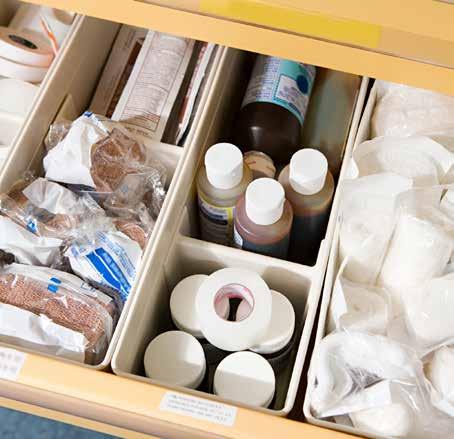
15 minute read
Dealing with Inflation
from JHC May 2022
Inflation – no matter when it strikes – is an unwelcome guest. Still, providers
are asking why now, when the American Medical Association reports that Medicare physician pay has increased 11% over the last two decades but the cost of running a medical practice increased 39% during that same time? Why now, just a few months after healthcare consulting firm Kaufman Hall projected that hospitals nationwide would lose $54 billion in 2021 and more than a third of U.S. hospitals would maintain negative operating margins through the year’s end? And why now, just as nursing homes were reported to have lost 220,000 jobs between March 2020 and October 2021 and were projected to lose $94 billion in 2020 and 2021?
Manufacturers and distributors are asking themselves similar questions, as the cost of raw materials and transportation keep going up.
How long will it last? How bad will it be? Well, in December, the Federal Reserve Board said it was committed to achieving “maximum employment and inflation at the rate of 2% over the longer run.” Other sources aren’t so optimistic. In the same month, mortgage financing firm Fannie Mae projected inflation would hit 7% in the Q1 2022 before decelerating to 3.8% by the end of 2022.
In the medical products and equipment industry, three factors will contribute the most to inflation in 2022, says Margaret Steele, senior vice president of med/surg for Vizient: rising labor costs, transportation costs and raw materials. “However, labor costs will likely have the most long-term impact as this metric doesn’t typically decline unless new technology is introduced to create more efficiencies in the manual labor aspect of production.”
Labor costs
“COVID-19 had a dramatic impact on the world’s workforce and production that we’re still feeling today,” says Kim Anders, group vice president, strategic supplier engagement for Premier Inc. Healthcare has also felt the pinch as workers in high-demand groups, from nurses to pharmacists to ICU physicians, have been in short supply and subject to a more competitive recruiting landscape. Early retirement and employee burnout have also contributed to the healthcare worker shortage.”
U.S. healthcare was experiencing a workforce shortage prior to the pandemic, but it has been exacerbated by the mental and physical strain of COVID-19, says Anders. She points out that healthcare had the second-highest quit rate (6.4%) in November of all industries. Among nursing homes, employment remains far below pre-pandemic levels, and hospitals and health systems remain nearly 100,000 jobs below their pre-pandemic peak in February 2020.
In healthcare, workforce shortages mean higher costs, not lower ones. An October 2021 Premier analysis revealed that U.S. hospitals were paying $24 billion more per year for qualified clinical labor than they did pre-pandemic, says Anders. For the average 500-bed facility, this translates to $17 million in additional annual labor expenses.
“Many hospitals and health systems were forced to turn to staffing agencies to supply urgently needed health workers to care for the increasing number of patients,” she says. “However, the pandemic’s longevity has pushed hospitals to rely on these temporary workers more than ever – ballooning the typical costs for travel staff.” Supply chain costs
As of mid-January, global logistics remained “an overloaded and stressed combination of port congestion, vessel shortages, equipment and container shortages,” says Anders. Not surprisingly, the cost of land, air and water transportation increased to record or near-record levels. Lead times for the manufacturing of additional cargo ships, shipping containers and freight trucks were also significant.
Although shipping container availability has improved slightly, costs remain at record levels, she says. Compared to prices in March 2019, freight rates from China to the U.S. increased 500 percent with spot rates up to about $10,000 per container, compared with the more typical price of $1,200. In addition, the pandemic and other restrictions have limited the availability of dockworkers and truck drivers, causing delays in cargo handling after it arrives at ports, she says. “There’s no clear consensus on how long this situation will last, with some experts assuming that these logistical challenges will remain for the foreseeable future.” leads to inflation but doesn’t necessarily lead to a greater demand for medical products, he says. Instead, it increases the cost of the raw goods, such as minerals and resins and other natural resources.
“If metals are diverted from the medical side to making higher-margin
goods, like washing machines, that will have an impact on the medical market,” says Clarke, who co-founded Health Products Xchange in 2018.
“It’s especially true for commodities, like crutches – though it also applies to things like suction canisters, OR towels and tubing,” he says. “In the case of crutches, there’s no sudden surge in demand, but the price of aluminum and logistics has increased 40% since the pandemic began. So you have a low-cost, bulky item – crutches – and the manufacturer can’t pass along all those costs, at least not immediately, given the nature of the U.S. healthcare system and the contracts between distributors, manufacturers and providers.” Consequently, manufacturers may lower their inventory of crutches and shift production to higher-margin goods. The result is a shortage of crutches, which can push up prices of that commodity.
Raw materials
All that notwithstanding, a key driver for inflation in medical products lies at their very source – that is, the raw materials needed to make those products, says E.V. Clarke, CEO of Health Products Xchange, whose HPXConnect is an electronic marketplace connecting manufacturers, distributors, providers and others. In most industries, too much money in the market
Clarke expects logistics and raw materials pricing to remain inflated for the next 12 to 24 months, and that’s not accounting for anomalies, such as rolling blackouts in China or domestic regulations about the sourcing of finished goods and even the raw materials used to make them. In economic storms such as the current one, alternative suppliers and brokers come out of the woodwork, he says. And that’s a market opportunity for digital marketplaces such as HPXConnect.
Todd Nelson, director of professional practice and partner relationships, and chief partnership executive for the Healthcare Financial Management Association, says that partnering with national, regional and local organizations will continue to be a key to addressing inflationary pressures. “For many it will take the form of looking at non-traditional partners to assist them in having access to products and equipment they depend on, which will

require a level of creativity, building trust and relying on additional clinical and financial evidence to build that
credibility with new partners.”
Think it through
What should providers and their suppliers do about inflation? For starters, avoid panicking.
Vizient believes inflation will contin-
ue through much of 2022, though at a lower rate than its most recent 7% pace, says Jeff King, research and intelligence director for Vizient. “Production costs will continue to put pricing pressures on product and service producers,” he says. “Vizient anticipates that raw material costs will decline, as resins already started their descent late last year. Unfortunately, the climbing labor costs won’t return to previous levels, and the issues impacting transportation appear to be long-term and will strain the ability of producers to maintain current price levels.”
“Everyone is facing increased costs,” says Steele. “However, it’s important that we look at these drivers individually. For instance, we may see some relief as it relates to ports and raw materials in the next few months, therefore those price increases should be temporary. However, labor shortages and increased labor costs are likely here to stay.
“Often, we look at all these factors collectively and accept the increased costs for the longer term,” she says. “We need to stay diligent and have transparent conversations with suppliers. This should allow for appropriate, temporary adjustments to ensure supply and business continuity rather than allowing the water line to rise across the board.”
ClinicDx

Get Diagnostic & Safety Essentials Delivered Faster
Get the diagnostic and safety essentials you need quicker and easier by shopping the expertly curated ClinicDx product portfolio. Order and get supplies delivered directly to your facility without the requirement of a purchase order. You’ll find hundreds of items in stock and ready to ship.
• CLIA-Waived Test Kits • CLIA-Moderate Test Kits • Rapid Test Kits • Specimen Collection Products • Diagnostic Equipment • Personal Protective Equipment (PPE) • Clinical Analyzers • Anatomic Pathology Products

Search for the products you order most often all in one place at: fisherhealthcare.com/clinicdx
Pricing strategies
For suppliers, contracting and pricing strategies only work when the economy for a category of goods or services is balanced, says John Strong, chief consulting officer for Access Strategy Partners, a national accounts consulting firm. “If I were still a supply chain executive in a hospital or health system, I would be more concerned about having goods available at a price that is reasonable and stop worrying about whether I’m getting the lowest price on everything.”
Lowest price isn’t the only measurable factor that goes into a supply chain executive’s annual goals and objectives, he says, Supply chain professionals are more likely to get fired due to declining order fill rates and services to the people on the front line. “A balanced scorecard requires looking at service levels, real value analysis and other factors – not just price.
“I’m a big fan of bringing products back to the U.S. to manufacture and sell,” he continues. “It provides meaningful work for our own country and has the added benefits of a shorter supply chain (and less carbon footprint) as well as the possibility of rebuilding industrial deserts in our largest cities. Yes, it is going to cost more in terms of a direct price. But I must ask, What have been the indirect costs to this country of offshoring much of our manufacturing base – inside and outside healthcare?”
Nor can supply chain executives “source” or “procure” their way out of the difficulties in today’s med/surg marketplace, says Strong. “You cannot get manufacturers to make things if they can’t make a reasonable profit. Consolidation has brought us to a total of three national GPOs, and many products that can be aggregated by them in a reasonable fashion already have been. Having scale, size and influence is important, but you can still reach a point in the economics of any goods or services where they cannot be provided any longer at a contracted price, [especially] in a period of short supply, inflation, supply chain/logistics issues or other factors along the supply chain.
“It is similar to the so-called ‘hog cycle’ in economics,” he says. “More farmers start to raise hogs when prices are high. This leads to an overall lowering of prices because of the increase in supply. So farmers get out of hogs and into something else because the price has become too low, driving prices up again. The cycle repeats itself.”
shortages and rising labor costs. Its PINC AI analytics technology can provide health systems with productivity benchmarks to pinpoint areas in need of adjusted staffing levels, says Anders. Premier also has contracts to help health systems control the costs of FTE and/or contingent staff for both clinical and non-clinical assignments.
Provider strategies
“While it may be difficult to identify what major U.S. or global events will impact the world’s economies and supply chain, Premier aims to arm our members with the information, tools and support needed to tackle cost imperatives,” says Anders. The company is accelerating the development of its MedSurg and ASCEND Inflationary Calculators so members can stay abreast of the most recent inflation estimates, she says.
In addition, through collaborations with Prestige Ameritech, DeRoyal Industries, Honeywell, Exela Pharma Sciences and VGYAAN Pharmaceuticals, Premier is producing “millions of domestically made PPE and pharmaceutical products ... thus helping to eliminate overreliance on overseas manufacturing and port congestion,” she says.
Meanwhile, the company continues to help hospitals and health systems deal with clinical and nonclinical labor
Buckle up
“Buckle up,” says Strong. “Many people working today don’t remember the Jimmy Carter years, when we witnessed a period of runaway inflation. I still remember being relieved to be able to get a threeyear variable mortgage note on a condo at 14.5%. The average rate at the time for a fixed 30-year mortgage was somewhere around 18%.”
The demand for medical products and services won’t go away, he adds. “The question for [providers] is, What price am I going to have to pay in 2022 to see those goods arrive on my receiving dock?”

Supporting the Supply Chain through Collaboration
The key to a healthy and agile supply chain is collaboration. Without the ability to work with other departments and organizations, your ability to meet the needs of your customers and their patients will suffer.
The Journal of Healthcare Contracting recently spoke to Karen Ryan, a Category Project Manager with Centura Health to discuss how non-acute facilities are expanding and how the supply chain can collaborate between non-acute care, supply chain distribution, and all critical access within that continuum. Meeting the needs of a diverse network
Centura Health has over 330 clinics across Colorado and Kansas, supported by a small, yet highly efficient, supply chain team. An organization that depends on collaboration to meet the needs of the
various clinics, Centura services patients in some of the ‘harder to reach’ areas in the country and does it well.
“The way our partnership is set up with our distributor McKesson MedicalSurgical is key to our ability to support our clinics at Centura,” Ryan said. “We have a wide range of needs, and we have a lot of clinics. We also have some challenging areas, the mountain areas. They operate uniquely in our system. They are open all year round. We have a lot of winter delays, delivery issues, winter storms – which creates some challenges.”
Ryan’s team supports Centura’s patients through direct delivery of supplies. McKesson has an on-site team at Centura, which allows the Health System to quickly and efficiently address any issues in real-time.
A supply chain in constant transition
Centura uses a consolidated model that not only reduces the total overhead costs for clinic space, but also reduces the vendor costs. Ryan said, “Our lead driver in clinic transitions is really our patient needs. In Colorado alone, our population has increased 14.5% over the last decade, one of the highest increases in the U.S. currently. Now that we have more patients, we need more providers and clinics to handle the influx of people.”
Because of this surge in Colorado growth, Centura has had to grow as well to keep up with the increase in patient visits. In the middle of a pandemic, Centura added a staggering 35 new clinics to meet those needs.

The value of collaboration
With so many moving parts in play, all at one time, it’s critical for an organization like Centura to collaborate with their internal teams on a day-to-day basis.
“For example, if I don’t have a vendor contract set up correctly, it affects price, billing errors, accounts payable, and it will create issues with our distributor. It affects so many people, internal and external. Until you drill down to it and see what your job role does and how it affects other teams, you’re really missing something.”
Without collaboration, Ryan and her team wouldn’t be able to get supplies and pharmaceuticals to the wide range clinics through Colorado and Kansas. “We’re always looking for ways to streamline processes, save time and money. Working with McKesson, their warehouse really helps us streamline those things. It gives us access to all our orders, so we can see back orders in real-time. We can also pull reports ourselves, improve processes, and the biggest is make changes to our formulary and make changes on the fly. We need that to be nimble.”
Take control of the non-acute continuum Non-acute supply chain strategies that support better patient outcomes Take control of the non-acute continuum Non-acute supply chain strategies that support better patient outcomes Take control of the non-acute continuum Non-acute supply chain strategies that support better patient outcomes
From doctor’s offices and surgery centers to patients’ homes, McKesson From doctor’s offices and surgery centers to patients’ homes, McKesson From doctor’s offices and surgery centers to patients’ homes, McKesson can help you develop a non-acute roadmap to improve care across can help you develop a can help you develop a your health system. non-acute roadmap non-acute roadmap to improve care across to improve care across your health system. your health system.
• • • • • • • • • • • • • • • • • • • • • • • • • • • • • • Operations Visibility Analytics Process Automation Supply Cost Management Standardization Laboratory Pharmaceuticals Post-Acute Care Leading Change Operations Visibility Analytics Process Automation Supply Cost Management Standardization Laboratory Pharmaceuticals Post-Acute Care Leading Change Operations Visibility Analytics Process Automation Supply Cost Management Standardization Laboratory Pharmaceuticals Post-Acute Care Leading Change

McKesson.com/TakeControl Medical-Surgical. Pharmaceutical. Lab. Equipment. McKesson.com/TakeControl Medical-Surgical. Pharmaceutical. Lab. Equipment. McKesson.com/TakeControl Medical-Surgical. Pharmaceutical. Lab. Equipment.


